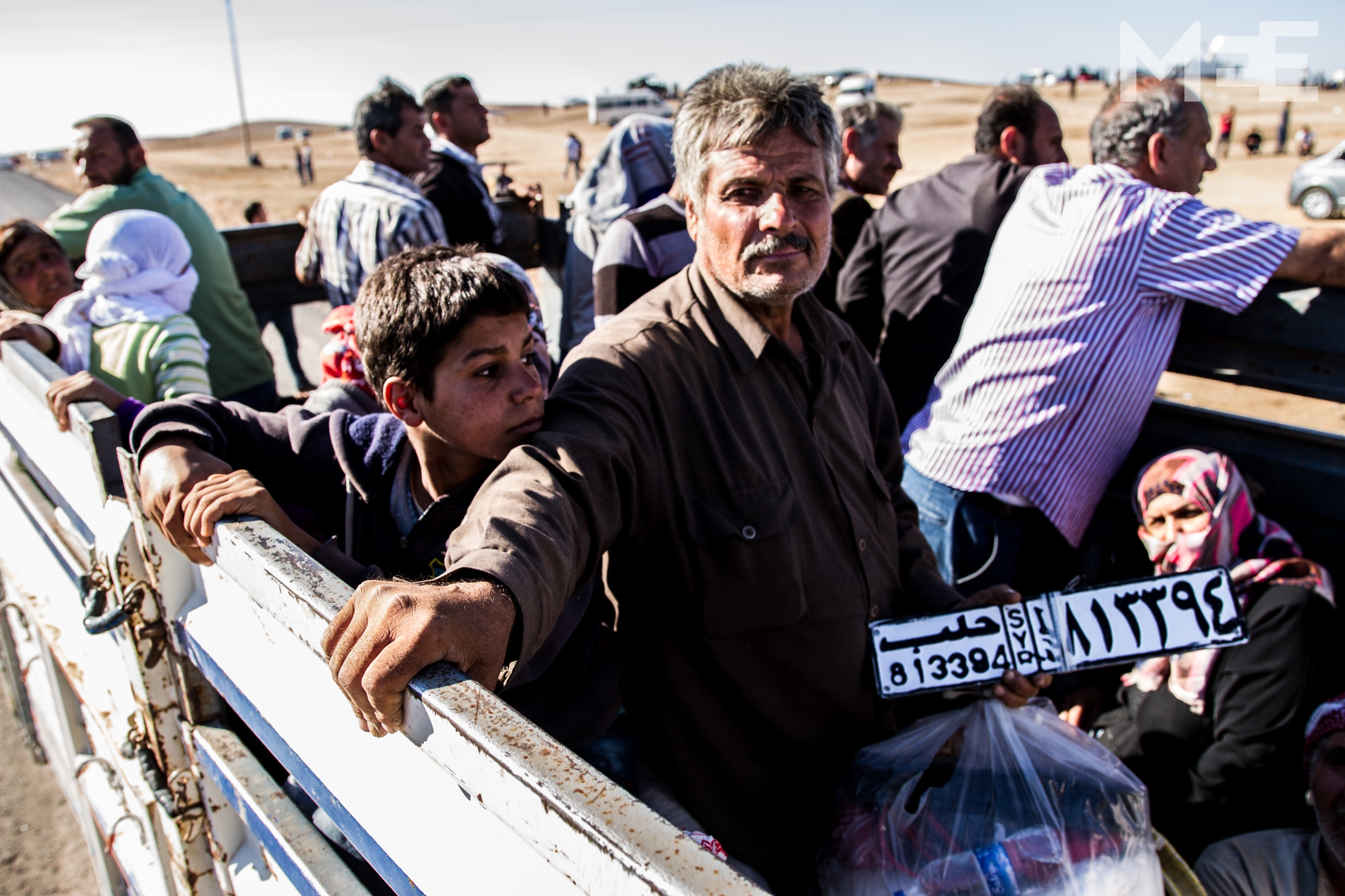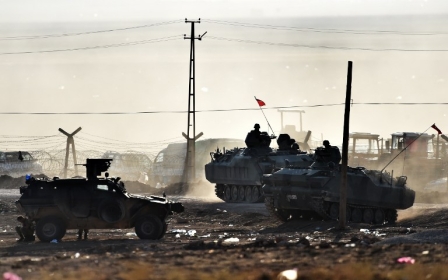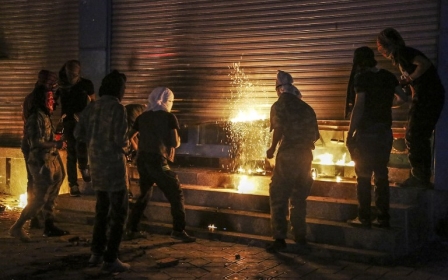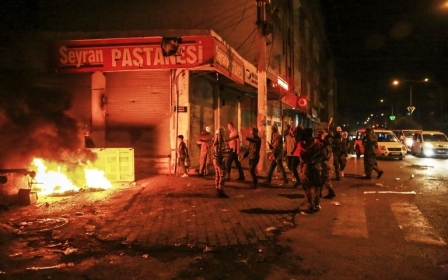Tent cities, gas canisters and anger at the Turkish-Syrian border

SURUC, Turkey - The roads in this rural town on Syria's border are overcrowded by 100,000 refugees that have fled Kobane in recent weeks. In three short weeks, parks and playing fields have been transformed into tent cities.
In an industrial area used to stock the basic goods collected by the city, Faruk Tatli, head of the Suruc municipality, coordinates the flow of rice and flour inside the warehouse. Tatli is also the international coordinator for Rojava, a Kurdish enclave in northern Syria that declared autonomy from Damascus in 2013 and named Kobane as its capital.
“ISIS existed even one year ago, and it already attacked Kobane,” explains Tatli while he organises volunteers loading and unloading trucks. “In that time, in the US and in Europe, nobody had an idea of what ISIS was. How is it possible that now is on the top of the agenda?”
"The government didn't make that much," Tatli says, two phones ringing in his hands at once, explaining how support has come locally, rather than from Ankara. While emergency stocks have been supplied by the local municipality and several other villages, much of the food has been offered by locals in Suruc who live just 7 kilometers across the border from Kobane.
In just one day, Tatli says 100,000 people crossed over the border - and they are still coming. Many of the estimated 180,000 Kobane residents who have now fled, he says, have family in Turkey and are now scattered across the country, lodging with these relatives - and pushing the number of Syrian refugees in Turkey past 1.2 milion.
“Unlike what happened in Sinjar in Iraq where the Peshmerga left the civilians alone," Tatli says, "the strategy of the YPG (People’s Protection Unit), the armed wing of the PYD (Democratic Union Party), has been to evacuate civilians before any fight gets close to the city."
A view of Kobane, a garden of gas canisters
On the road between Suruc and Kobane in recent days, only pick-ups full of people, military convoys and police cars have passed. Next to the last military checkpoint, photographer's cameras and recording equipment sit on the top of a small hill that marks the entrance to the “Point Zero”. It is here where most Turkish army vehicles stop, with only a few tanks closer to the border that is about two kilometers further.
Past the check-point are several more tent cities, built on the side of the road near abandoned railway tracks where barbed wire delineates the Turkish-Syria border.
At Point Zero, many people gather to anxiously following the siege. Over the weekend, bombs exploded inside the city.
"We have to live day and night with the explosions,” Egdi, a leader in the Kobane community, tells MEE. Egid lives inside the “Point Zero” and is present as tens of people come each day to discuss what is happening, exchange information, debate and find solutions for stranded families.
From Egdi's house, a tall man in his forties looks outside the window showing at his house in Kobane. Mortars are falling close to it.
And in his garden, where a nearby Turkish tank monitors the border, a collection of gas canisters liter the yard, ones that he said the Turkish army threw to disperse solidarity demonstrations held in recent weeks for the remaining people inside Kobane - now largely just YPG fighters. Many of the people who demonstrated asked Turkish officials to let them pass the border to fight.
“They told me that in the nearby village, ISIS entered to steal some cars, under the noses of the militaries, but we are not allowed to pass,” explodes Egdi. “They throw us teargas and they threaten us, you understand? They open the border for ISIS, but not for us.”
Egdi and other locals have said it’s no secret that many foreign fighters and IS militants have entered Syria from the Turkish border. Last week, US Vice President Joe Biden told a Harvard University audience that Turkish President Recep Tayyip Erdogan had admitted letting in "too many people through" in reference to the thousands of militants who are suspected of having crossed its borders.
"I have never said to him that we had made a mistake, never," Erdogan responded. Biden subsequently was forced to apologise for his comments.
“Did you hear of that ISIS group on the train from Antakia?” asks Kamal Oskan, a Syrian journalist now living in Gaziantep. “Once close to the border, when the train slows down, they jumped off the train and cross the border into Syria. They even fired rockets, but the Turkish side did not answer."
Oskan, together with many Gaziantep’s citizens, says that there are IS fighters all over the southeast region of Turkey “even here in Gaziantep. They have their neighbourhoods, their safe houses and even their doctors; they come here to recover when they are injured."
'We ran away on 19th of September at 4:30 pm'
Kamiran Mdirs is a focal point of Kobane, a reference person of the city and the nearby villages. For the past two weeks, he has lived with all his family in his cousin’s house, who was born and raised in Suruç. Here, 30 people now live together in two rooms.
“We ran away on the 19th of September at 4:30 pm,” says Naze Hussein, Mdirs' niece. "For 16 days, we could not sleep because of the bombings. When they told us to evacuate because ISIS was near, we escaped with the very same dresses we were wearing”. While Naze describes those moments, everyone shiver in reviving them. Mdirs, with a nephew on his legs, reminisces about his town.
“Kobane has always been a multi-cultural and multi-confessional town," he says. "We always had good relations with our Arab neighbours. We helped each other, we even hosted those escaping Alep in our houses but now many of our own neighbours are with ISIS! Why?”
In November 2013, Rojava - a collection of the three cantons of Kobane, Afrin and Al Jazeera which Kurds refer to as Syrian Kurdistan - was established under the leading role of the PYD. Since then, the YPG has taken control in almost every Kurdish areas in the provinces of Aleppo, Hassakah and Raqqa.
Attacks from the Islamic State group have been constant since then, but Rojava, says Oskan, has resisted.
“Rojava still represents the hope for thousands of Kurds, to see [jailed PKK leader Abdullah] Ocalan's political project realised: 'democratic autonomy' and local 'self-administration',” says Oskan.
“Rojava territories is all along the south Turkish border,” explains Tatli, “and if Turkey wants to establish this buffer zone (as voted in the Parliamentary motion of the 2nd of October) it is to digest the gains of Rojava."
Questions about Ankara's intentions
Ankara would not only deploy Turkish troops in Syrian territory in the buffer zone, but it would also relocate the Syrians refugees that are now in Turkey. PYD and PKK leaders perceive this motion as a demographic strategy, bringing a million Arabs to separate the Kurds geographically, in particular the PYD from the PKK.
“It is very clear that Ankara does not want a united and strong Kurdish force on its borders," says Oskan. In Iraq, Erdogan has formally recognised the leadership of Masoud Barzani, president of Iraqi Kurdistan Region, and the sovereignty of the KRG. Turkey has also become a strong commercial partner importing KRG oil, for example.
“But it did not recognise the PYD, nor Rojava, and this for two main reasons: for the non-aggression pact between PYD and Assad, and for its affiliation to the PKK," Oskan added.
Precisely in Kobane, locals feel Ankara has revealed its strategy: to patiently wait for the YPG to be weak enough to need the military help of Turkey. In this way, they believe, the PYD would lose its negotiation power and could accept the Turkish pressures to enter inside a coalition against Syrian President Bashar al-Assad.
However, in order to make this happens, Erdogan needs an agreement with the PKK. Indeed, the PKK not only shares a long-term political vision with the PYD, but it is also the only actor that is now supporting the PYD and the YPG in Kobane left to fight on their own.
“Even though the strict military controls at the border, the resistance manages to enter Kobane to fight,” says Tatli. When asked how many PKK units are inside Kobane, Tatli prefers to remain vague. "Even if there are PKK members, once they are in Kobane, we have to consider them as YPG militias."
While Turkish forces have been firing teargas on the Suruç demonstrators, there are thousands of fighters in the streets of Kobane trying to push back Islamic State.
“With the exception of the PKK, we are totally alone," says Mdirs. “The Kurds have no friends other than the mountains."
New MEE newsletter: Jerusalem Dispatch
Sign up to get the latest insights and analysis on Israel-Palestine, alongside Turkey Unpacked and other MEE newsletters
Middle East Eye delivers independent and unrivalled coverage and analysis of the Middle East, North Africa and beyond. To learn more about republishing this content and the associated fees, please fill out this form. More about MEE can be found here.




